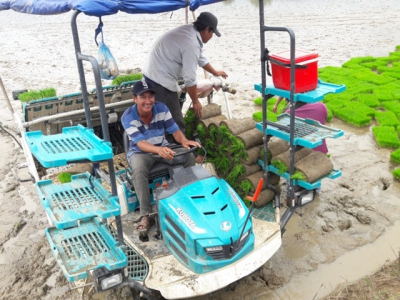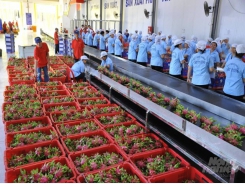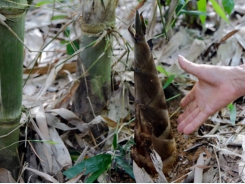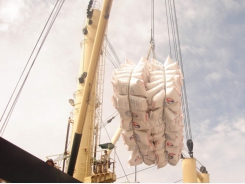Widely applying SRI technique to water-scare provinces

The System of Rice Intensification, known as SRI is warmly welcomed by farmers in Binh Thuan province as they have seen a lot of benefits when applying this technique.
Binh Thuan agricultural sector guides farmers to adapt SRI combined with mechanization. Photo: AB.
Rice cultivation applying SRI, hundreds of benefits
Binh Thuan province has over 50,000 ha of rice land with more than 110,000 ha of cultivated area per year (winter-spring, summer- autumn and autumn- winter). Average rice production reaches 650,000-700,000 tons per year. Rice is mainly cultivated in four districts including Tanh Linh, Duc Linh, Ham Thuan Bac and Bac Binh.
Currently, Binh Thuan farmers grow 3 crops per year and most of the rice land in the province applying flood irrigation. With this watering technique, one hectare of rice requires nearly 2.5 times more water than any upland crop.
In recent years, as drought conditions got worsen for the province; severe water scarcity occurred more often. At the end of rainy season, the reservoirs did not store enough water volume as design capacity. As a result, farming area was cut down every year.
To cope with the situation, the application of advanced techniques for rice production to increase yield, production and quality of rice is an urgent and basic task.
According to the Binh Thuan Agricultural Extension Center, over the past time, in addition to guiding farmers to cultivate crops according to the concept of ICM, IPM, in the winter-spring crop in 2016-2017 and summer-autumn crop in 2017, the center carried out many advanced rice farming models adapting The System of Rice Intensification (SRI), evaluating planting density and applying alternate wetting and drying in rice fields in the districts of Tuy Phong and Ham Thuan Bac.
Besides, the Center also conducted community farming at sparser sowing density on 50 hectares of rice fields in Long Huong and Long Dien 1 Farming Cooperatives (Tuy Phong district).
Director of the Binh Thuan Agricultural Extension Center, Nguyen Tam said the application of SRI in rice production is considered as the goal of sustainable agriculture, minimizing negative impacts on agricultural environment thanks to saving water, using less pesticide and fertilizers, reducing required seed.
To help farmers realize benefits of SRI, the Center tested 4 sowing recipes including sowing 8 kilograms of seed per sao (1,000 square meter), 10kg/sao, 12kg/sao and 16kg/sao (control field) and made comparisons.
After the two first crops, farmers participating in the model saw clearly that when sowing the seed at sparser density (80kg/ha) the yield was highest with 78 quintals/ha; followed by 100kg/ha density with a yield of 77 quintals/ha; 120 kg/ha density with a yield of 73 quintals/ha and 160 kg/ha with 71 quintals/ha. In addition, conventional rice fields with sowing density of 200-250 kg/ha, average yield reached only 72 quintals/ha.
"In term of economic efficiency, with sowing density of 80kg/ha the profit will be VND25.5 million per ha; and with sowing density of 200kg/ha in conventional rice production, the profit is VND20.7 million. So, the difference between the two recipes is VND4.7 million per ha. If the application of SRI in rice production help reduce watering by 4 times per ha per crop, the conventional farm applying traditional flood irrigation requires watering 12 times per ha per crop (nearly 3,333 cubic meters of water are saved)", Tam analyzed.
Target: Over 4,000 ha of rice cultivation using SRI method
With practical benefits and towards responsible and sustainable agriculture, contributing to the restructuring of the agricultural industry, in recent years, the Binh Thuan Agricultural Extension Center has maintained and expanded the SRI rice farming area in the province by 50-100 ha per year.
Nguyen Tam added, in addition to cultivating rice using SRI with sparser sowing density, since 2017-2019 crop year, the center has implemented SRI rice cultivation using rice transplanters with a sowing density of 50kg/ha.
Application of SRI in rice production combined with rice transplanters has been expanded in Binh Thuan.
The model was deployed on 170 ha in Tanh Linh district and proved positive result with average productivity of 6.9 tons per ha (0.7 tons/ha higher than control field); turnover of VDN 41 million per ha, profit of over VND22 million per ha. While conventional rice field created VND40 million per ha and the profit was VND16 million per ha.
In 2020, the Center not only built a pure SRI rice farming model but also continued to elevate rice cultivation applying SRI technique towards organic farming under chain linkages using ST 25 rice variety on 30 hectares in Ham Thuan Bac and Bac Binh. The model gave average yield of 58 quintals per ha and selling price from VND7,500-8,000 per kilogram; meanwhile for conventional rice farming model, average yield ranged from 58 to 60 quintals per ha and the selling prices were below VND 7,000 per kilogram.
“Currently, the Center continues to maintain and replicate SRI rice production model to the key rice cultivation areas such as Tanh Linh, Ham Thuan Bac, Bac Binh and Tuy Phong. Accordingly, up to now the whole province has about 700 ha including nearly 100 ha expanded by local farmer through the application of this method.
Especially, in 2021, the Center has implemented SRI rice production model for the first time on 5 hectares in the ethnic minority area in Phan Son commune, Bac Binh district,” Tam shared, adding that the province’s agricultural sector set a goal by 2025 the SRI rice cultivation area in the province will reach nearly 4,000 hectares.
The application of SRI technique helps save water, seed, fertilizer, minimizing pest and disease attacks.
Reducing required seeds for transplanting by above 50%
Nguyen Anh Duc, Director of Duc Binh Agricultural Service Cooperative in Duc Binh commune, Tanh Linh district (Binh Thuan province) said previously, local farmer sowed seed at a density of 25-30 kilogram per sao. However, since implementing the project sponsored by SNV Netherlands Development Organization, the Binh Thuan Agricultural Extension Center helped Duc Binh Cooperative apply the system of rice intensification- SRI in the 2018-2019 winter-spring crop.
In the 2019-2020 winter-spring crop, the Center continued to implement the model again, helping gradually change local farmers’ cultivation practices. Particularly, the cooperative has nearly 20ha with 9 members. They now use only 12 kilograms of seed for one sao combined with organic rice production.
Thanks to SRI technique, in the recent consecutive crops, the Cooperative saw few pests and diseases in rice fields. Especially, the field has never been attacked by brown plant hoppers because of sparser sowing density. As a result, the costs for fertilizers and pesticides were cut down by 20-30% compared to conventional rice farms. However, because the cooperative grow organic rice they have to use microbial fertilizer which is safe, non-toxic and environmentally friendly.
Duc Binh Cooperative cultivates 3 crops of rice each year on average. The yield reaches 70-80 tons per year. The cooperative’s organic rice product is always sold well.
Related news
Tools

Phối trộn thức ăn chăn nuôi

Pha dung dịch thủy canh

Định mức cho tôm ăn

Phối trộn phân bón NPK

Xác định tỷ lệ tôm sống

Chuyển đổi đơn vị phân bón

Xác định công suất sục khí

Chuyển đổi đơn vị tôm

Tính diện tích nhà kính

Tính thể tích ao



 GCP progress towards sustainable coffee
GCP progress towards sustainable coffee  Rice is Vietnam's No. 1 commodity exported to…
Rice is Vietnam's No. 1 commodity exported to…